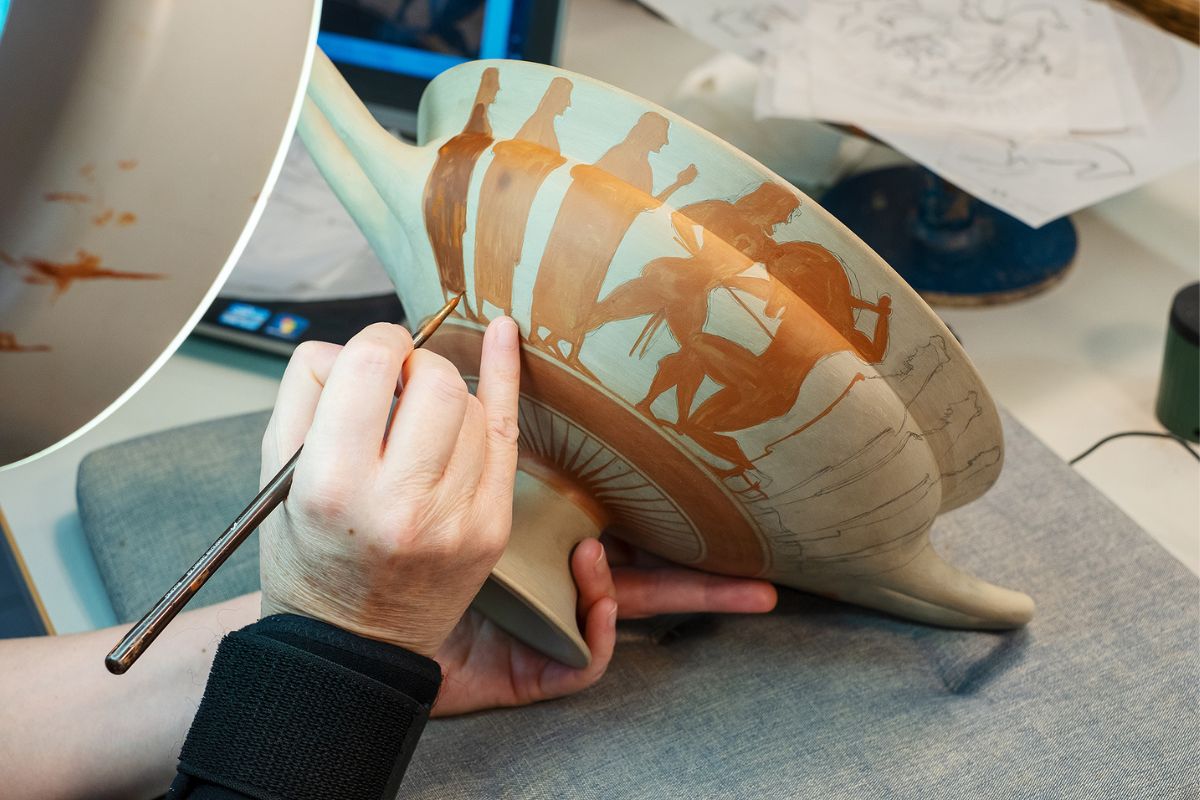
This article explores how ancient Greek pottery painting reflects daily life, beliefs, and art in ancient Greece.
Key Highlights
- Ancient Greek pottery painting forms a critical piece of ancient Greek art and offers valuable insights into the beliefs and stories of its civilization.
- Black-figure and red-figure vase painting techniques were significant milestones in artistic evolution.
- Originating from earlier Minoan and Mycenaean pottery, these styles paved the way to later Hellenistic innovations.
- Greek vases were more than functional; they were symbolic, reflecting daily life, ceremonies, and mythological tales.
- Iconic pieces, identified through inscriptions, continue to guide the study of ancient Greek art and society.
- Scholars rely on pottery as a major source within the archaeological record to trace historical timelines and cultural contexts.
Ancient Greek pottery painting is one of the most well-known parts of ancient Greek art. These painted Greek pottery pieces help us learn a lot about daily life, old stories, and what people in ancient Greece thought about the world. Greek vase painting is easy to spot in the archaeological record. It is proof that the Greeks had a smart art style that joined together usefulness and beauty. The painted Greek vases show scenes from both home and important events, and you can see how their style changed over time. Greek vase painting gives us a look into their culture and shows how deep ancient Greek art really is.
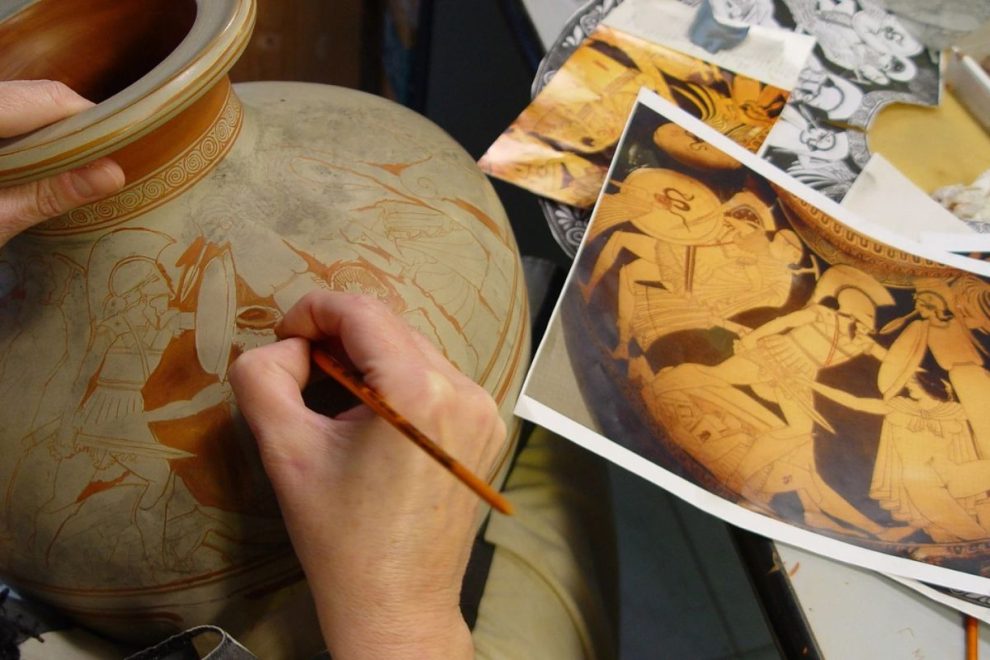
Origins and Historical Context of Ancient Greek Pottery Painting
Pottery of ancient Greece grew to be an important craft during early Archaic Greece. It was a big part of the daily life and buildings of the time. Greek artists learned a lot from Minoan pottery and made the craft their own. They made new pottery styles and added significant details to the art. The broken pieces from this time help people today to see the skill and meanings in their work. At first, early pottery painting in ancient Greece was simple. People used it every day, so it was plain. Over time, the designs got more decorated and people started to put patterns and pictures on their ceramics. As the years went by, pottery of ancient Greece began to show much more. Stories, society habits, trading, and myths were often painted on the pots. These changes help us know how people lived and what was important to them in early Archaic Greece.
Early Pottery Traditions in the Aegean World
Aegean pottery began with Cycladic pottery. This style used simple shapes and had a calm, quiet look. Most of these pieces were made for use, not just to be pretty. Still, there was a hint of art in their clean and plain designs. After Cycladic pottery, the style moved toward Mycenaean pottery. This new phase showed much more detail and skill. Makers put scenes of sea life and shapes from nature on the clay. Mycenaean pottery showed the way the people could be more creative with both the shape and decoration. This change happened in the late Bronze Age.
Minoan pottery came next and stood out for its great skill and style. The makers of Minoan pottery added careful, detailed lines and bold shapes. These patterns made it look valuable and brought the art forward. Minoan ceramic work helped shape the way ancient Greek, Greek pottery, and ancient Greek pottery artists used symbols and pictures when they painted their own pots years later.
Influence of Minoan and Mycenaean Cultures
Minoan pottery changed many parts of Greek vase painting. Their advanced ways of making pots and their styles made a big difference. Minoan grave markers also showed that ceramics were very important in ceremony and life. Mycenaean pottery also had a clear effect on later Greek vases. It used a lot of designs from nature and told stories with myth. It helped bring symbolic storytelling into Greek vase painting. You can see that, whether with sea patterns or words for special uses, both Minoan and Mycenaean groups helped make pottery a good way to express ideas. This helped Greek vase painting move to forms people liked in early archaic Greece.
Materials and Techniques Used
The types of clay that people used in ancient Greek pottery made a big difference to the quality and strength of the vases. Attic clay, known for its high iron content, gave the vases their well-known orange-red color after being fired. Workers used many tools like the potter’s wheel and thin brushes. They worked together to shape the pottery and add details. The way they shaped the pottery on the wheel and painted it showed how skilled the artisans of ancient Greek times were, even though they lived so long ago.
Types of Clay and Their Sources
Different kinds of clay were used by ancient Greek artisans. Each type was chosen for a reason. The well-known Attic clay was unique because it had a lot of iron in it. This gave the pottery a red-orange color. The black glaze, which many people notice about Greek ceramics, came from mixing clay with ferrous oxide. To get this black glaze right, the timing during the firing step had to be just right. Every region where they got clay had its own feel. This changed how the pots looked in the end. With these clay colors, all the vases from both ancient Greek areas and southern Italy looked bright and different in shape and form.
Tools and Methods of Pottery Shaping
Ancient Greek pottery took shape using potters’ wheels. The people who made the pots used simple tools to form different shapes like amphorae and kraters. Shards of pots were joined with clay slip. This helped people put together parts to make large or different pieces. The workers also added looks and details or made the pots work better at this stage. They changed the tools they used, like brushes and carving tools, to show how old ways could change to fit a task. This made sure each vase could be right on size but still had its own look and feel. This is why ancient Greek and Greek pottery is still known for both quality and style.
Key Shapes and Functions of Ancient Greek Vessels
The shapes of vases in Greek pottery, such as large geometric amphorae, were made to match their use. Amphorae were used to hold liquids. Hydrias were made to carry water for use at home. Greek pottery had a role in big events too. Panathenaic amphorae held olive oil that was given out as prizes in competitive games. This shows someone how these vases were important for social rituals. The different uses of a Greek vase show how the Greek people mixed daily needs and art when they made Greek pottery.
Everyday Domestic Uses
Domestic vessels like hydrias and kylixes show that the shapes of these vases were practical. Hydrias had three handles to help people carry and pour water with ease. This made them helpful and comfortable to use every day. Vessels such as Panathenaic amphorae also show how useful these ancient pieces could be. At home or at friendly events, people would use these beautiful Panathenaic amphorae for several tasks. The decoration did not stop them from being items people used often. The size, strength, and simple look of these objects let them fit well into daily life in ancient Greece. But they were not just plain—they still looked great. These features made them items most households in ancient Greece wanted to have. People would use them every day and enjoy their beauty at the same time.
Ceremonial and Funerary Purposes
Ceremonial and funerary practices in ancient Greek society used pottery painting as a way to talk about their beliefs. Decorated vases were put on graves and often acted as grave markers. These pots were important for honoring the dead and helping them on their way to the afterlife. The images painted on these vases showed mythological figures and scenes. These pictures reflected the beliefs of the ancient Greeks. There were many shapes, like amphorae and kraters. The ways that people made and painted these vases made them look good and showed us what they meant to the people. These vessels were used in rituals and memorial gatherings and give us a window into ancient Greek life.
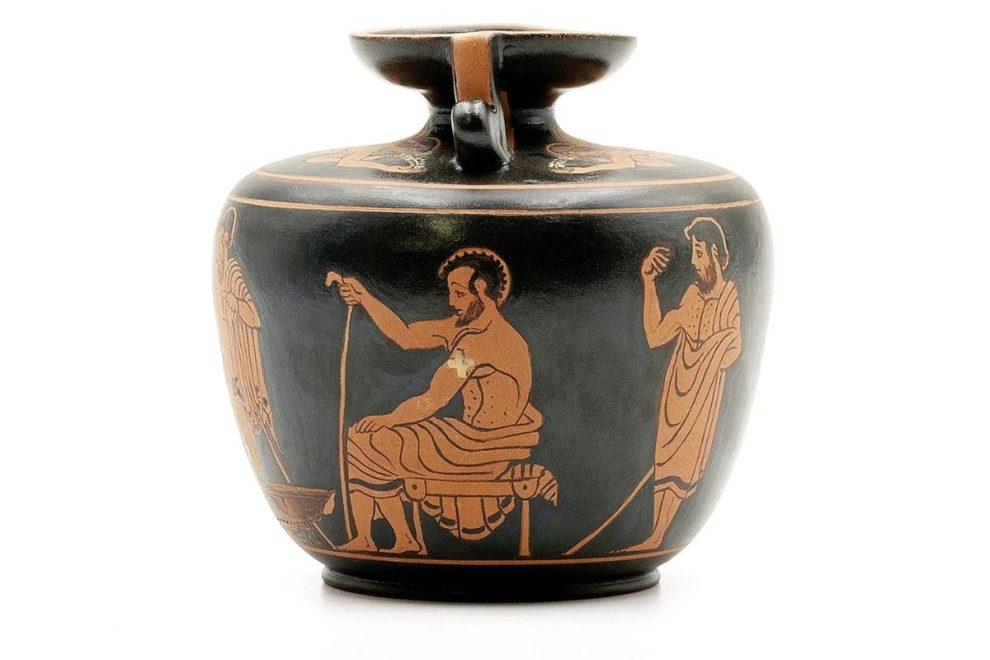
Major Styles in Ancient Greek Vase Painting
Different styles in Greek vase painting showed cultural shifts and new art ideas over time. The first style, called geometric style, used detailed patterns and shapes that did not look like real things. Next came the Orientalizing period, where artists added images from Eastern cultures to their work. After that, the black-figure and red-figure vase painting styles changed how artists showed human figures. These two techniques made the scenes look more real and active. Every style lets us see the beliefs of the ancient Greeks. Each vase painting shows what people from that time cared about. These Greek vase paintings became a way to keep their history and ideas alive. Also, these styles had a big influence on the art of the later Hellenistic period.
The Stone Age
Evidence from the Stone Age shows that people made simple pottery with basic markings. This time set the stage for later Greek art and the start of Greek pottery. People then started to show more skill and interest in making different vessels. The styles from the Stone Age were not as detailed as what you see in later Greek pottery, but they were the beginning of useful and pretty pots. Modern scholars find these early pieces interesting. They help us understand how cultural practices changed in ancient Greek societies. Over time, these early examples helped shape ancient Greek pottery and its important place in other civilizations that came after.
The Bronze Age
Pottery from the Bronze Age is more than just art. It also shows the daily ways of ancient Greek life, particularly for burials. Graves were sometimes found to have skillfully made vases and items for ceremonies. This can tell us a lot about the beliefs of the ancient Greeks and their views on life after death. The vessels often have paintings of mythological figures and symbols. These decorations show what the people thought was important and how they cared for the gods. People keep digging in places in southern Italy and the Aegean to find new pieces. Each new find gives us more details about how ancient Greek art was made and why it still matters today.
The Iron Age
During the Iron Age, Greek vase painting changed in many ways. These changes came about because the way people lived and what they believed in also changed. At this time, a new style called geometric art started. In this style, you can see simple shapes, detailed patterns, and human figures that are not complex. There would often be scenes on the Greek vases showing stories from myths and what people did each day. As people from other places met the Greeks, many new ways of painting and other styles showed up. Later on, Athenian vase painting began to take in new ideas, with more detailed images, because of these contacts. The changes in Greek vase painting were important, because they helped ancient Greek art grow and move forward. The work in geometric art and the designs on vases tell us much about ancient Greek times and the things people found important back then.
Protogeometric and Geometric Style
The protogeometric and geometric styles show an important change in ancient Greek pottery painting. These styles are easy to see because of their clear patterns and shapes. They started to appear in the late dark age. This was a time when art came back to life, and many vases showed repeated circles, meanders, and straight signs on the outside. These ways of decorating do not just show what people in ancient Greece liked to look at. They also help us learn a lot about the social and events during that time in ancient Greek history. We can see the beliefs and values of the people through this ancient Greek pottery and the way it was made.
Orientalizing Styles
In the Orientalizing period, the pottery looked quite different from before. The vases had lots of detailed patterns and animal shapes. The designs on these vases showed how ancient Greek art was shaped by ideas from the East. It was easy to see animal figures and busy flower shapes on many of the Greek vase surfaces during this time. This style change happened as trade and contact with people from places like the Near East increased. These new influences started a big change in Greek vase painting and made ancient Greek art richer. Because of these styles, the archaeological record of ancient Greece became more interesting and showed how the people and their ways mixed with others. Today, these vases help us see how important trade and art were in ancient Greece.
White Ground Techniques
White ground techniques started to be an important way of decorating ancient Greek pottery, especially in the later archaic and classical times. In this method, artists put a white slip on the surface of a pottery piece before adding detailed pictures. These pictures often showed stories from myths or scenes from daily life. The white background made the colors stand out more, which helped the pictures look clear and bright. While older styles of Greek pottery, like black-figure and red-figure, were common before, white ground pottery was mostly used for events or funerals. Many of these pieces were used as grave markers. They show us what the beliefs of the ancient Greeks were, and they give us a look into their lives during those years.
The Hellenistic Period
The Hellenistic period brought about big changes in pottery. There was a move to show fine skill and to be truer to life. Earlier pottery styles had strict shapes, but now artists focused on lively human figures and scenes that were full of action. Many of these showed stories from mythology or scenes from everyday life. One big step was using the white ground technique. It let artists add more color and detail to their work. This time also showed a mix of cultures from around the Mediterranean. People can now see these changes in the archaeological record. It helps us know more about how the beliefs of the ancient Greeks grew and changed with time.
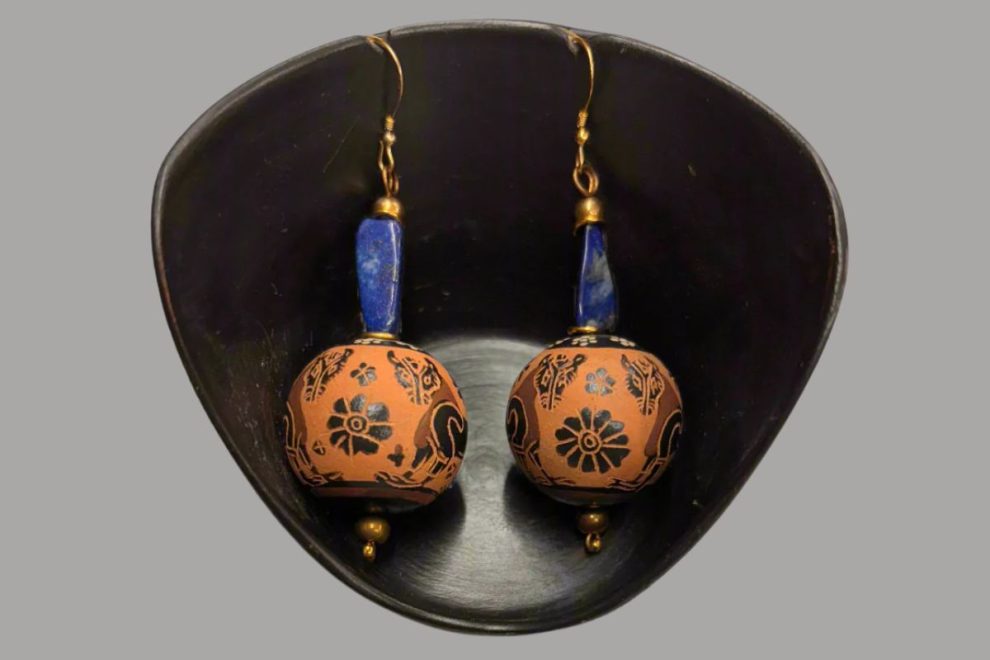
Black-Figure Pottery: Development and Characteristics
The black-figure pottery technique started in the late 7th century BC. This style brought out clear details that helped shape Athenian vase painting. Artists would paint people and scenes using a shiny black slip. This paint made the designs stand out against the reddish clay. The new style in ancient Greek art was a big step forward for artists. It let them show more mythological figures and moments from daily life. This helped people get a better understanding of Greek society at that time. As black-figure vase painting became more popular, it set the stage for new changes in ancient Greek art.
Technique and Process of Black-Figure Painting
The skill of black-figure painting stands out because of how the artist uses a deep black slip to create figures on the red clay of Greek vases. The artist would then carefully scratch lines into the black slip. This helped make fine, clear lines that show the beauty of mythological figures, as well as daily life. After the vases were fired, the surface would get a shine that made the colors stand out even more. The whole process was not just about skill. It also lets us see the beliefs of the ancient Greeks through these scenes. That is why these vases are so important, as they help us know more about their lives and ideas.
Prominent Artists and Iconic Works
In ancient Greece, there were a few artists who changed the world of pottery painting. They stood out because of their styles and the way they told stories. Big names like Exekias and Pan Painter are well known for how good they were at both black-figure and red-figure painting styles. These artists showed great skill when they painted stories from myths and daily life. Their work, such as the famous amphorae, shows the beliefs of the ancient Greeks in many ways. It helps us see what life was like back then and how people thought and felt. These pieces of Greek art are important in the archaeological record. They let us learn about what was important to people at the time and what they thought was beautiful.
Red-Figure Pottery: Evolution and Impact
A big change happened in ancient Greek vase painting with the start of red-figure pottery. This new way of making a Greek vase let artists show more detail and much better human figures than before. With this, Greek art in the classical period grew in new ways. Artists could now tell stories on figure vases with more feeling and clearer scenes. The use of red-figure ceramics is easy to see in the archaeological record. You find a lot of these vases, mainly in southern Italy. This shows there was a lot of cultural exchange during that time. In ancient Greece, red-figure pottery was both a method and a way to show art. It made a lasting mark on Greek vase painting and on other art styles that came after.
Differences Between Black-Figure and Red-Figure Techniques
Each technique used in Greek vase painting was made to show the detailed art that was a big part of ancient Greek life. In black-figure vase painting, artists put a black slip on to make figures stand out against the red color of the clay. This way, they can scrape into the black to show the lighter clay, which gives more detail. Later, artists started using red-figure vase painting. This different way kept the figures in the clay’s natural red color by covering the background with a black slip instead. The switch from black-figure to red-figure vase painting did not just change how the art looked. It also made it possible to show human figures in more lifelike ways and tell even more stories on Greek vases. This helped Greek vase painting grow over time into something even more meaningful.
Notable Painters and Masterpieces
Great potters in ancient Greek vase painting, like Exekias and Panaitios, left a big mark with their well-known work. Exekias is famous for his black-figure style. He was able to show scenes from myths on Greek vases, like the popular one where Ajax and Achilles are playing a game. Panaitios showed the beauty of the red-figure way on Greek vases. He was able to show human figures with bright detail and real depth. These vases show how skilled the creators were. They also help us see what was important to people in their art and culture back in that time.
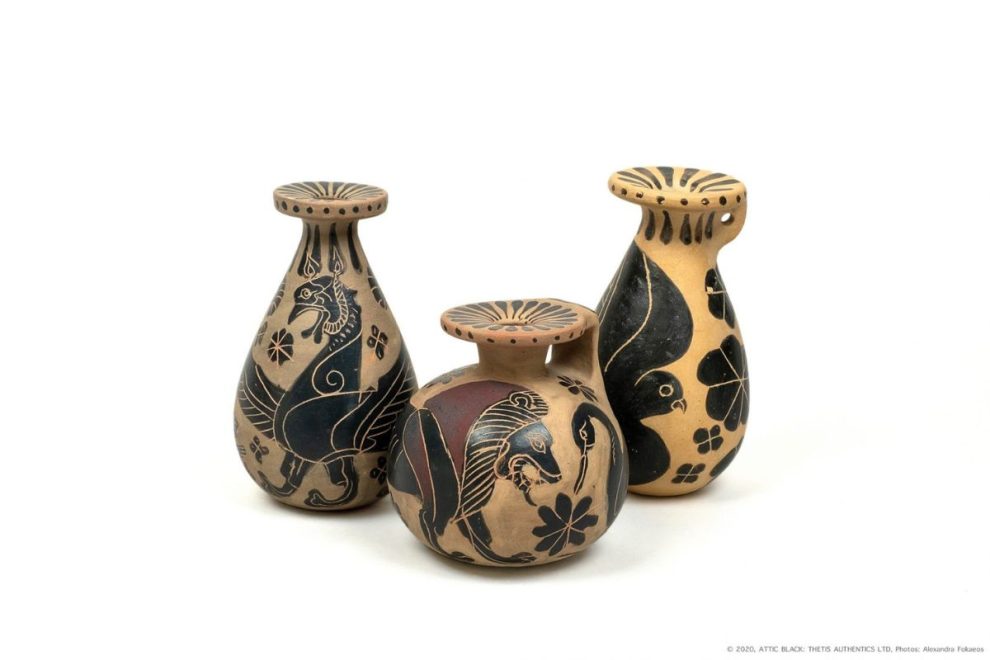
Themes and Iconography in Ancient Greek Pottery Painting
Ancient Greek pottery is full of detailed themes and important images. These designs show the beliefs of the ancient Greeks and what their daily lives were like. Many figure vases have stories from mythology on them. The ancient Greeks often used gods, goddesses, and heroes in their artwork, which was a big part of Athenian culture. There are also many scenes that show sports, home life, and people getting together. These pictures help us see what life was like in ancient Greek society. The way these themes come together in ancient Greek pottery makes the stories stronger and helps keep important parts of their culture safe over time. This is why ancient Greek pottery is still important today.
Mythological Narratives and Heroes
Mythological stories show up often in ancient Greek vase painting. You can see what people of that time believed in and what they thought was good or bad. These greek vase paintings usually show big, brave acts from famous mythological figures like Heracles and Achilles. These greek vases help us see what great moments from legends looked like back then. With careful designs and clear pictures, the vases were more than everyday objects. They also worked as a way to teach, showing the value of being brave and honest. The scenes on greek vase painting still teach us a lot about the mind of the ancient Greeks and what their society thought was important.
Daily Life, Athletics, and Social Scenes
Ancient Greek pottery often shows the busy and colorful daily life of the people. On the greek vase, you can see all kinds of things people used to do and how they spent their time. There are many pictures of athletic events. Some of these are about the Olympics. They show how much the ancient greek people cared about being strong and about having fun as a group. The greek pottery also paints scenes from all types of social events. You see people at big meals, or at a symposium, where they would talk and relax together. This helps us find out more about what mattered to them and how they lived. Modern scholars look at all this art. It helps them to know about the ancient Greek customs, what they liked, and what daily life might be like back then. These pictures are a great way to see what life was truly like in ancient Greek times.
The Role of Inscriptions and Signatures
Inscriptions and signatures on ancient Greek pottery help us learn more about Greek art and the lives of people in ancient Greek times. These marks tell us about the artists, their workshops, and give us clues about life back then. Sometimes the markings show messages, who owned the pottery, or dedications. These details help us understand the beliefs of the ancient Greeks, their social rules, and who was important in society. When modern scholars study these pieces of ancient Greek pottery, they find out more about how artists and people were connected.
Identifying Artists and Workshops
Finding out where ancient Greek pottery comes from needs a close look at the style and any writing on it. Some vase painters would leave their own name or mark. This helps to tell which workshop made the pottery. The way the pots were made, like the red figure or black figure styles, and the shapes of vases, also help figure out their origin. Experts study even small shards of pots in detail. By doing this, they can match pieces to a certain artist or workshop.
Messages, Dedications, and Ownership Marks
Inscriptions found on ancient Greek pottery give us a good look into how people lived and what was important to them. Some messages and dedications on the pottery are made for gods. Others mark events or show how people felt about something. Marks of ownership, either as inscriptions or as symbols, show how much value was placed on pottery. These objects were linked to trade and social status as well. Such details help us see the connection that people had with their ancient Greek pottery. They also help us see how vase painting played a big part in rituals and in daily life for many people. By looking at these elements, we get a better understanding of Greek society, how one’s life was shaped by their objects, and what was important in that time. These things are very helpful for anyone trying to know more about the past and the old ways of life.
The world of vase painting in ancient Greece shows us a lot about what people believed and how they lived every day. When you look at the styles, the ways things were made, and the subjects in this art, you get to see how ancient Greek pottery painting and Greek art changed from the geometric time to the Hellenistic period. Greek pottery is still very important in the archaeological record. It lets us see what was in the minds of people from ancient Greece. These pieces also keep inspiring modern scholars and people who love history today.
